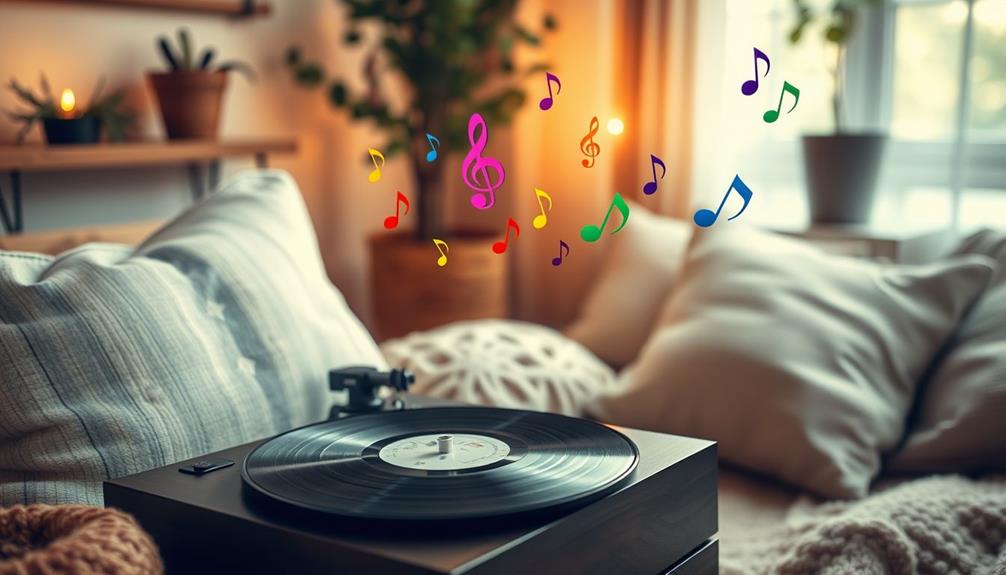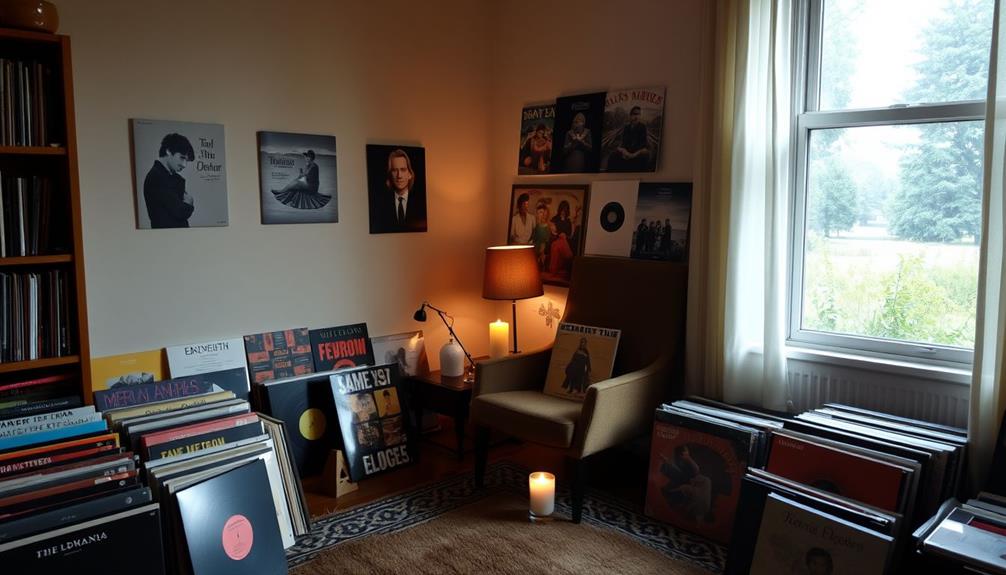Creating a healing playlist is a powerful way to support your emotional health. Start by identifying songs that resonate with your current feelings and curate tracks that guide you toward a more positive emotional state. Arrange them to tell a story, moving from pain to hope. Include a mix of uplifting and reflective tunes from various genres, and don't forget to regularly update your playlist as your emotions evolve. Find a distraction-free space for focused listening and reflect on the lyrics to deepen your understanding. There's so much more to discover about crafting the perfect playlist for your healing journey.
Key Takeaways
- Identify songs that resonate with your current emotional state and curate additional tracks that lead toward a desired emotional state.
- Arrange songs to create a narrative arc that transitions from pain to hope, enhancing emotional processing.
- Regularly update your playlist to ensure it reflects your evolving feelings and emotional needs.
- Experiment with diverse genres to discover unique emotional responses and enhance the healing experience.
- Create a distraction-free environment for focused listening, incorporating relaxation techniques to deepen emotional engagement.
Importance of Music in Healing
Music plays an essential role in the healing process, acting as a powerful tool for emotional support and recovery. When you listen to music, you mightn't realize how it impacts your emotional state. Research shows that it decreases stress hormones and boosts dopamine release, promoting overall emotional well-being. This makes music a highly effective therapeutic tool during challenging times.
Additionally, just like the innovative approaches of unique mushroom coffee pods that enhance health benefits, music can also serve to uplift and energize your spirit.
As you navigate complex feelings, music provides comfort and helps you express emotions that might be hard to verbalize. Curated playlists can regulate your emotions during distress, fostering a sense of safety and facilitating the healing process. Different genres resonate differently with individuals, creating unique connections that can enhance your mood and support emotional recovery.
Engaging with music also offers a soothing source of support, reducing stress and anxiety levels when you need it most. Whether you prefer calming melodies or uplifting beats, the right music can transform your emotional landscape.
Steps to Create Your Playlist

Creating a healing playlist can be a transformative experience, especially if you start by identifying a couple of songs that truly resonate with your current emotional state. This step allows you to acknowledge and reflect on your feelings. By curating a playlist that captures the essence of your emotions, you can begin to heal and process those feelings in a healthy way. In a leading music therapist interview, it was mentioned that music has the power to evoke and express emotions, making it a powerful tool for emotional healing and self-reflection. By incorporating this understanding into the creation of your healing playlist, you can take the first step towards finding healing through music.
Just as astrology explores personality traits, your emotional state can guide your song selection, enhancing the connection between music and personal experience. Once you've pinpointed those initial tracks, curate 3-4 additional songs that lead you toward a desired emotional state. This balance between uplifting and somber themes is essential in creating a playlist that supports your journey.
Next, consider the narrative arc of your playlist. Arrange your selected songs to shift from pain to hope, enhancing the overall healing experience. This thoughtful progression will make your playlist more impactful.
Don't forget that your emotional landscape changes, so it's important to regularly update your playlist. This guarantees it remains relevant and continues to support your healing journey.
Lastly, take advantage of streaming platforms to create and manage your playlist easily. With just a few clicks, you can access your music anytime, making it simple to listen and engage whenever needed.
Personalizing Your Music Selection

Understanding your emotional landscape is key to personalizing your music selection. Start by identifying songs that resonate with your current feelings. Consider incorporating tracks that evoke memories of past friendships, as they can help ground your emotional experience and provide a sense of connection, much like how reviving old friendships can bring joy and support.
Choose tracks that reflect specific emotions tied to your healing journey, creating a personal connection that can deepen your experience. Aim for a balanced mix of uplifting and reflective tracks to craft a narrative arc that shifts from pain to hope. This can greatly enhance your emotional processing and resilience.
Don't hesitate to explore diverse genres and artists; different styles evoke unique responses, helping you navigate complex emotions more effectively. Remember to regularly update your playlist to keep it fresh and aligned with your evolving feelings. This guarantees that your selection remains relevant to your current emotional needs.
As you listen, take the time to reflect on the lyrics and themes of the songs. This practice not only deepens your emotional awareness but also facilitates self-reflection, further enhancing your mental health.
Emotional Awareness Through Music

When you listen to music, you can start to recognize emotional triggers that influence your feelings.
This awareness helps you process complex emotions and enhances your self-reflection skills. Engaging with AI-generated music can further enhance your emotional exploration, as it offers diverse soundscapes that resonate with different moods.
Recognizing Emotional Triggers
Music has a unique ability to tap into our emotions, often bringing to the surface feelings we mightn't even realize we're holding. By recognizing emotional triggers through music, you can identify songs that evoke specific feelings or memories, especially those tied to trauma. This practice helps you process your emotions, making music a powerful ally in your healing journey.
Understanding the importance of mastering music production software can also enhance your ability to create playlists that speak to your emotional state.
Engaging with tracks that resonate with your personal experiences allows for deeper emotional awareness. As you listen, take time to reflect on the lyrics and their impact on your feelings. This reflection can help articulate your emotions and provide clarity about your emotional state.
Curating playlists focused on these triggers can aid in maneuvering through distress, promoting a sense of safety as you move from pain to resilience.
Regular emotional check-ins while listening to your playlist enhance self-awareness, enabling you to recognize shifts in mood. If a song stirs up unexpected feelings, adjust your playlist accordingly.
Processing Complex Feelings
Engaging with music offers a powerful way to process complex feelings, serving as a safe outlet for emotional expression. When you immerse yourself in melodies and lyrics, you can enhance self-awareness and gain emotional clarity.
Incorporating practices like mindful eating can complement this emotional journey by fostering a deeper connection with your feelings. Here are some ways to leverage music for processing your feelings:
- Reflect on Lyrics: Listen closely to the lyrics and think about how they relate to your own experiences. This helps you identify and label feelings that might otherwise go unrecognized.
- Explore Diverse Genres: Different genres evoke varied emotional responses. Experimenting with different styles can lead you to specific songs that resonate with your current state.
- Create Thematic Playlists: Curate playlists that reflect your emotional journey, whether it's pain, healing, or joy. This can provide a structured way to navigate through trauma.
- Update Regularly: As your emotions shift, update your playlists to match. This encourages ongoing emotional processing and fosters a dynamic relationship with music as a therapeutic tool.
Enhancing Self-Reflection Skills
A well-crafted playlist can serve as a powerful tool for enhancing self-reflection skills and emotional awareness. Engaging with music allows you to check in with your emotions, helping you recognize and label your feelings. By reflecting on song lyrics during listening sessions, you gain clarity and confidence in processing complex emotions, making music invaluable for self-reflection.
To effectively create your healing playlist, consider the following elements:
| Element | Purpose | Example |
|---|---|---|
| Personal Experience | Resonate with your feelings | Songs from significant moments |
| Genre Exploration | Broaden emotional understanding | Mix of pop, classical, and indie |
| Regular Updates | Mirror changing emotions | Monthly refresh of playlists |
Curating playlists that resonate with your experiences aids in maneuvering through life's ups and downs, promoting emotional exploration and healing. Experimenting with various genres can help identify what music evokes positive or negative feelings. Regularly updating your playlist facilitates ongoing self-reflection and emotional growth, making your healing journey dynamic and relevant.
Exploring Different Music Genres

Diving into various music genres can alter your healing playlist into a rich tapestry of emotions and experiences. Different genres evoke distinct emotional responses, allowing you to tailor your playlist based on your current mood.
Here are four genres to contemplate incorporating:
- Classical: Known for its calming effects, classical music can help promote relaxation and introspection, much like how brewing techniques can enhance the enjoyment of coffee.
- Pop: Upbeat and catchy, pop tracks can boost your energy and motivation when you need a pick-me-up.
- Jazz: With its improvisational flair, jazz invites creativity and can evoke a sense of nostalgia or calm.
- Ambient: This genre creates a serene atmosphere, perfect for mindfulness and deep relaxation.
As you explore these different genres, you'll find that the tempo, rhythm, and melody considerably influence your mood.
Sharing Playlists for Community Support

While you create your healing playlist, consider sharing it with others to foster a sense of community and connection. Sharing playlists can help you bond over shared musical experiences and emotional journeys, providing both you and your listeners with much-needed emotional support.
Engaging in cooperative play through music can enhance your emotional well-being and help build stronger connections with others.
Social media platforms are great for amplifying the reach of your curated playlists, making them accessible to a wider audience seeking healing. Encourage feedback and song suggestions from your listeners; this collaboration enriches your playlist, infusing it with diverse perspectives and emotional resonance.
Moreover, playlists can serve as conversation starters in support groups, facilitating discussions about shared experiences and the therapeutic power of music.
When you share music, you not only inspire others but also enhance your own healing process, creating a sense of comfort and solidarity in times of distress.
Listening Strategies for Healing

To truly benefit from your healing playlist, create a distraction-free environment where you can focus entirely on the music.
Incorporating relaxation techniques can enhance your listening experience, allowing you to fully immerse yourself in the melodies.
As you listen, take time to reflect on how the songs and lyrics make you feel; this deeper engagement can help clarify your emotions.
Experimenting with different genres can also open up new emotional pathways, enriching your healing journey.
Focused Listening Environment
Creating an ideal listening environment is essential for enhancing your connection with music during healing sessions. A focused listening environment allows you to dive deeper into the mental and emotional aspects of the music, paving the way for a transformative experience. Here are some strategies to set the stage:
1. Choose a Distraction-Free Space: Find a quiet area where you won't be interrupted. This helps you immerse yourself in the melodies and lyrics, fostering emotional reflection.
Engaging with music can be a powerful tool for wellness inspiration, allowing you to explore your feelings more thoroughly.
2. Set Aside Dedicated Time: Allocate specific moments for listening. Intentional engagement with your playlist encourages greater emotional awareness and processing.
3. Experiment with Genres: Try different styles and artists to discover what resonates with you. Each genre can evoke unique feelings, enhancing your healing journey.
4. Create a Comfortable Setting: Adjust the lighting and seating to promote relaxation. A cozy environment can greatly enhance the therapeutic benefits of music, making the experience more immersive.
Emotion Reflection Techniques
Engaging with music as a healing tool involves employing specific emotion reflection techniques that deepen your connection to the experience.
Begin by creating a distraction-free environment where you can actively listen. This helps enhance emotional processing and self-awareness. Utilize emotional check-ins while listening; identify and label the feelings that arise in response to specific tracks. This practice aids in understanding and managing complex emotions.
Explore diverse genres to discover which music resonates with your emotional state. Different genres evoke varied emotional responses, enhancing your healing journey.
When crafting your playlist, create a narrative arc. Start with songs that reflect your current emotional pain and gradually move to tracks that inspire hope and resilience. This change facilitates a journey through your emotions.
Regularly assess and update your playlist to reflect your changing emotional needs. Keeping your music relevant guarantees it continues to promote emotional healing and well-being.
Resources for Further Exploration

Music therapy offers a wealth of resources for those looking to deepen their understanding and application of healing playlists. By exploring different avenues, you can enhance your experience in listening to your playlist and utilizing music as a therapeutic tool. Here are some valuable resources to contemplate:
- Online Platforms: Utilize Spotify and YouTube for curated music playlists tailored to emotional needs. These platforms provide easy tools for playlist creation, allowing you to customize your experience.
- Books and Guides: Check out "The Therapeutic Aha!" for strategies that promote client breakthroughs through music. Additionally, read user-friendly guides on trauma treatment to learn practical skills for incorporating music into therapy sessions.
- Workshops and Courses: Attend workshops focused on the integration of music in therapeutic practices. These events broaden your understanding and application of music therapy techniques.
- Networking Opportunities: Engage with professionals in the field. Networking can help you share insights and resources related to music therapy's healing potential, enriching your approach to music playlists.
Frequently Asked Questions
How Do I Create a Good Playlist?
To create a good playlist, start by selecting songs that resonate with you. Mix genres, balance tempos, and regularly update it to reflect your mood. Don't forget to include tracks that uplift you!
What Is a Therapy Playlist?
Music's the universal language, and a therapy playlist is your curated collection of songs that help you connect with emotions, reduce stress, and promote healing. It's tailored to your needs, reflecting your journey.
Where Can I Create a Free Music Playlist?
You can create a free music playlist on popular streaming platforms like Spotify, YouTube, and Apple Music. These services offer user-friendly interfaces, collaborative options, and curated playlists to help you discover new music easily.
How Do You Make a Mood Playlist?
To make a mood playlist, start by identifying your current feelings. Choose songs that resonate with you, then add tracks that uplift or reflect. Experiment with genres, and arrange them to create an emotional journey.
Conclusion
As you curate your healing playlist, remember that music has the power to transform your mood and support your emotional journey. Think about how certain songs make you feel—can you envision the moments they evoke? By personalizing your selections and exploring various genres, you create a unique soundscape that resonates with your healing process. Embrace the journey, share your playlists, and connect with others who understand the power of music in fostering well-being.










